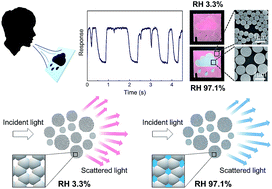Ultrafast humidity-responsive structural colors from disordered nanoporous titania microspheres†
Abstract
We demonstrate humidity-responsive structural colors with ultrafast rise and recovery times of 20 and 36 ms from a random arrangement of amorphous titania microspheres. A large fraction of the amorphous titania microsphere is shown to be nanoporous, permitting significant changes to the effective permittivity upon water uptake and thereby altering its scattering cross section. Individually, the microspheres are indistinguishable by scattered light in dry and humid environments, but collectively display color contrast in both environments as the incoherent scattering from each particle allows the individual scattering cross sections to be summed in the far-field, exposing smoothly varying spectral features unique to the humidity environment. Time-resolved humidity response measurements of the microspheres show ultrafast response times due to the fast diffusion dynamics of water molecules in the titania nanoporous network. Absence of spatial ordering among microspheres for generating color also facilitates the fabrication of a simple binary humidity-responsive display, optimized in speed and signal at only a monolayer coverage of particles. As the sensing relies on changes in the scattering cross-section, signal detection can be performed using a monochromatic light source that demands little power (30 μW in our demonstration). Such results suggest intriguing possibilities for realizing cheap, simple, ultrafast and power-efficient colorimetric humidity sensors using structural colors from disordered systems.



 Please wait while we load your content...
Please wait while we load your content...